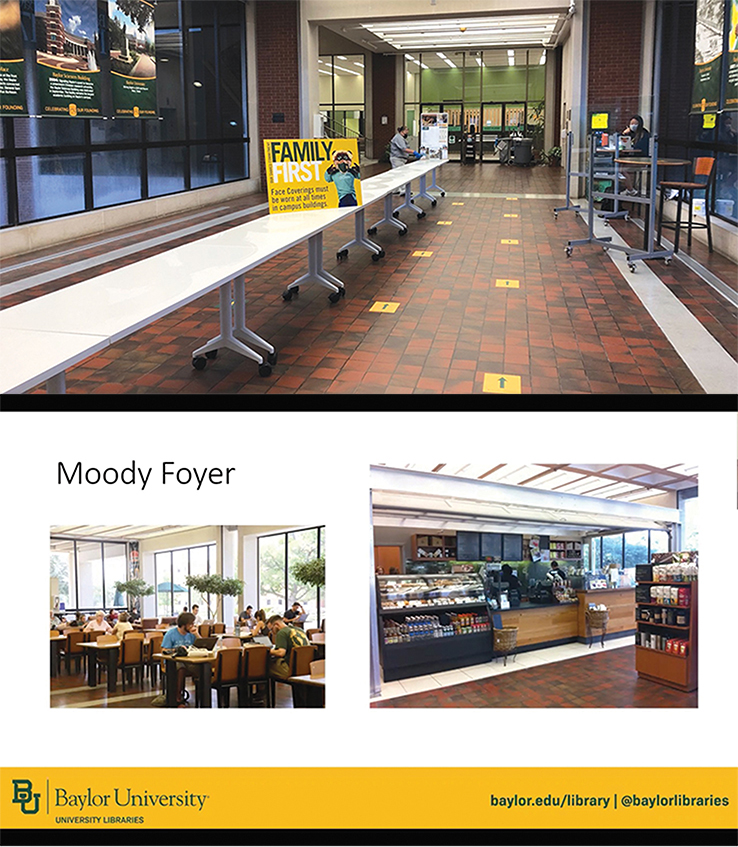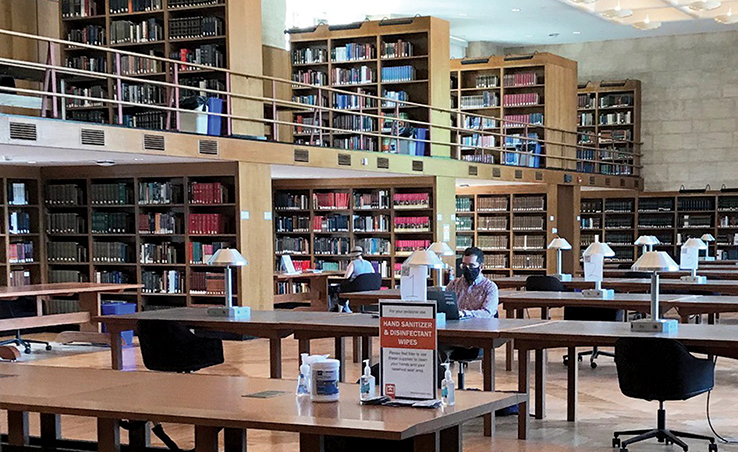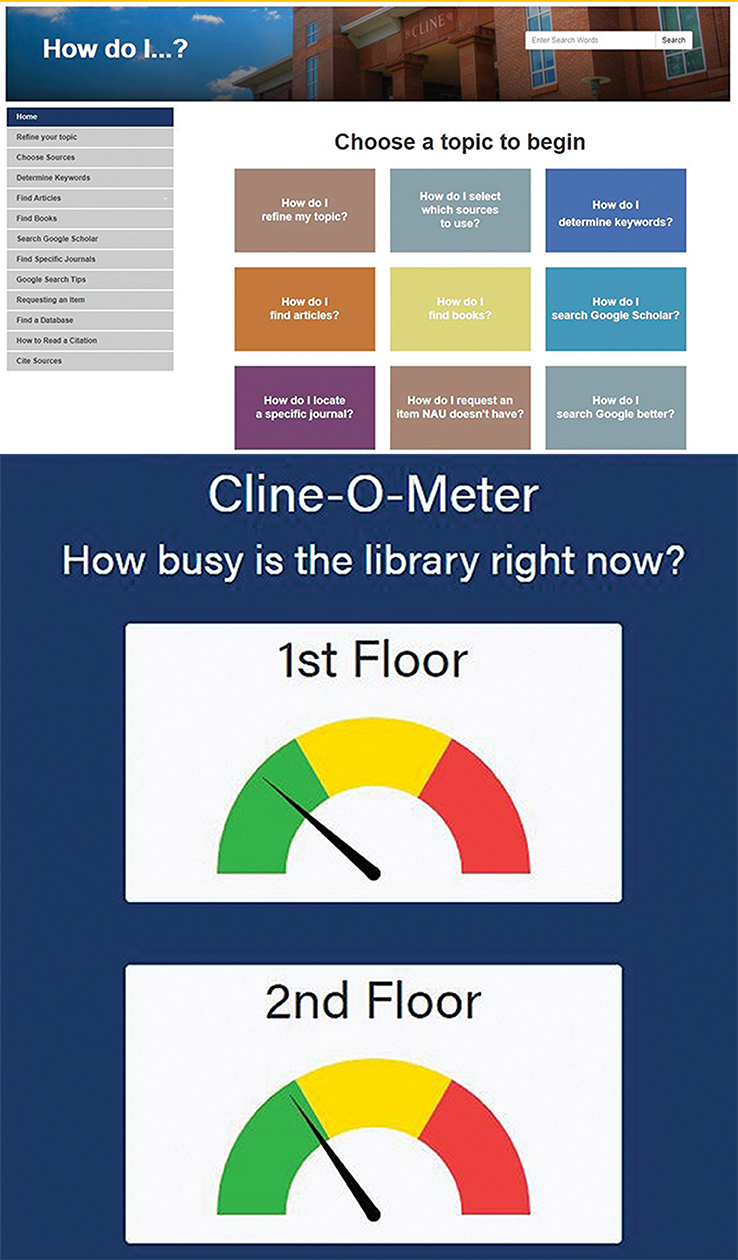Equipping First-Year Students for Remote Success
As colleges and universities pivot to remote and hybrid models, their libraries must find new ways to welcome and orient new students.
Students starting college this fall are encountering a completely transformed academic experience, as the vast majority of normally in-person higher education institutions across the United States have pivoted to a wholly or primarily online experience. This, of course, includes libraries, typically among the first on-campus organizations to welcome first-year students and train them for the demands of college-level academic work.
 |
In Baylor University’s Moody Memorial Library, the entrance (top) features signage directing students to distance and wear masks, as well as a “counter” who keeps track of users and housekeeping staff, who keep surfaces clean. The library’s foyer (bottom) allows plenty of space for socially distanced seating |
SHAPING GOOD RESEARCHERS
At Northern Arizona University (NAU), Flagstaff, which is implementing a hybrid online/in-person model for the current semester, librarians at the Cline Library have utilized online support for first-year programming for several years already. Librarians have expanded the use of this online content for fall 2020. According to Theresa Carlson, a librarian in teaching, learning, and research services, a prerecorded information literacy basics tutorial will remain part of the first-year curriculum for many students, including in freshman composition courses. This online tutorial is “lengthy,” says Carlson, and will review how to find and evaluate information, why researchers might use different types of sources like books and articles, and citation in different styles. It is arranged in a handful of modules, so that faculty can pick and choose which ones they want their students to watch. Some modules are tailored for specific courses, such as freshman biology.
Carlson offered this tutorial as an option to professors teaching in the NAU First Year Experience program—meant to support those students entering college with an academic deficit—but this year will be connecting with those classes through a live Zoom training. In prior years, Carlson physically visited those classes for a hands-on information literacy session, and professors “still felt it was more important to have that personal connection,” she says.
At Emerson College in Boston, librarians have typically seen every student at some point in their first year, through an in-class information literacy lesson. “We are hoping to continue to do that, but obviously not in person,” says Outreach Coordinator and Reference Librarian Cate Schneiderman. The library instruction team has been brainstorming creative ways to engage students in these lessons, Schneiderman says, including the use of discussion threads, Zoom breakout rooms, and synchronous and asynchronous options, available depending on faculty needs.
Librarians at Princeton University, which is wholly online for undergraduate studies this fall, joined in the class of 2024’s remote orientation and offered interactive online information sessions. Librarians introduced students to the resources available and answered their questions, “particularly about how we can support them during this period of distance learning,” says Anu Vedantham, assistant university librarian for research services. The Princeton University Library will also continue, remotely, the practice of pairing first-year students with a personal librarian who can guide them through the research references available to them. The library is also providing how-to videos and library research modules—covering basic research tasks such as using the catalog and accessing collections—through a course management system. Faculty may choose to utilize these modules as part of their courses as well.
 |
Princeton University’s new Study-Browse Service allows students to reserve seats in designated spaces, such as the Firestone Library’s Trustee Reading Room, for up to eight hours |
KEEPING IT SIMPLE
Librarians, accustomed to frequent student interactions and teaching opportunities at the reference desk or in informal conversations, understand that a short class drop-in or prerecorded video cannot adequately introduce first-years to the library and to good research skills, which they may or may not have been exposed to in their K–12 classrooms and libraries. They have worked to provide other online information tools, like LibGuides. According to Carlson, at NAU “we have built a simplified subject LibGuide for every subject” that automatically goes into students’ course management platforms. This way, she says, “a freshman in any department, not just the specific first-year courses, can access it.” These LibGuides are designed to be extremely simple, with several good databases to kick off research, a quick search box, and a link to contact the library.
The Iwasaki Library at Emerson College is also utilizing LibGuides, including pre-COVID guides, to enhance student outreach. “The distance learning student guide has pretty much everything you’re going to need to do remote learning,” says Schneiderman. In addition, Schneiderman intends to send out a regular series of emails to students, “with this week’s or month’s library tidbit.” Sending students information on the library in small doses, rather than in one long tutorial, could help get the information across in a more digestible manner. “We attempted to come up with a way to convey everything all at once, and we basically re-created the website—there’s just so much,” says Schneiderman. In all communications, she adds, “we want to focus on what is possible, not on what is different. The great news is, in a modern library, a significant amount of the resources are available online. And hopefully, the silver lining is this is the year that people realize this, or at least they get used to it.”
Throughout these efforts, librarians must manage their own expectations, given competing demands on students’ time and attention. At Baylor University in Texas, where students have returned to campus, the library had limited uptake on Zoom library orientations, tours, and Q&A sessions. “There were days we had zero sign-ups for our online orientation sessions due to the competition with other sessions offered at the same time,” says Carl F. Flynn, director of marketing and communications for the University Libraries. The libraries had better outcomes with New Student Resource webpages, incorporated in the online New Student Orientation, and with short “ProTips” videos, shared online and through social media. The greatest success came from the library’s offer of free “Baylor University 2024” stickers, which the library advertised through social media and mailed to requesting students’ homes. “The stickers provided an immediate connection with students…and gave us an email list we could use throughout the rest of the summer to judiciously engage incoming students as the day approached of their campus arrival,” says Flynn.
WELCOME TO THE (VIRTUAL) LIBRARY
Librarians typically conduct tours of the physical library space, orienting first-year students to the building layout and rules, as well as showing them the friendly faces of library staff. Some library orientation remains particularly necessary for schools that are allowing students access to the library this semester. At NAU, where the library will be open during regular hours this fall, creation of an online library tour was in progress, and almost complete, when COVID hit. NAU has more than 30,000 students; with faculty frequently requesting tours and only a small number of librarians, the online tour was intended to ensure all students were introduced to the library. “We still have faculty who want students to have the library experience, and here’s a virtual option,” says Carlson. One downside of having recorded the online tour pre-pandemic, however, is that it no longer reflects the library’s social distancing setup. “It [shows] a lot more tables than what we actually have now,” says Carlson.
At Emerson College, there is normally a large open house at the library as part of new student orientation, featuring karaoke, a raffle, arts and crafts, and an opportunity to explore the space. That event will, obviously, not be possible this year, and librarians instead plan to get creative in how they welcome and connect with first-year students. Schneiderman plans to create a “virtual open house” with a scavenger hunt on the library website, ideal because Emerson recently introduced a new library website. “It’s a great time for us to be launching this website and letting people know” what they can accomplish with online databases and ebooks, says Schneiderman.
Princeton University librarians are using chat and social media to maintain connections with students. Extended reference chat hours will accommodate remote students in different time zones. Social media campaigns, particularly through Instagram, will inform students about library news, initiatives, and events. “Our main priorities during this unusual time are to assure new students that they can count on us to support their learning and research, and that we will help them in every way we can to have an academically successful first year,” says Anne Jarvis, Robert H. Taylor 1930 University Librarian.
At Baylor, where many students are on campus and taking in-person classes, students who received online library orientation are making use of the library, “even though some of them never visited campus prior to day one of classes,” says Flynn. Students will continue to interact with public services staff in the library, and there are plans to feature virtual events and exhibits in library spaces throughout the semester to continue engaging new students. “We are off to as good of a start as we can imagine,” says Flynn, in light of necessary pandemic limitations such as limited seating and social distancing. The libraries may never go back to in-person orientation, which has traditionally demanded more time and resources from staff and students, “so we will only be challenged to think creatively and improve our initial connection that makes for an engaged learner in our spaces and relative to our resources.”
 |
NAU’s How Do I Libguide (l.) and Cline-O-Meter (r.), which allows students to see
|
COMMON CHALLENGES
While many library resources, including librarian reference expertise and instruction, remain available to first-year students online, this does not perfectly replicate the on-campus experience. “We would have loved to engage with them in person and introduce them to the multitude of physical spaces that support their research and learning, including collaborative workspaces, makerspace, and the visualization studio,” says Princeton’s Vedantham. “The challenge in adapting the first-year experience is conveying the full library experience and cultivating relationships in a virtual environment.” Nevertheless, Vedantham tells LJ, the online environment can offer opportunities to “creatively engage with students” through social media, chat, how-to videos, and online training modules.
In her quest to connect with first-year students, Susan Lee, senior librarian at the University of Providence in Montana, faces two challenges familiar to many academic librarians: limited resources and uninterested faculty. While in the past first-year orientation took place in the library, giving librarians the chance to welcome students and show them library basics, no such programming is in place for the fully online fall semester. Lee is working to connect with faculty and request a window of time in their first-year courses to deliver a live online library tutorial. Availability will depend on faculty interest, Lee says. “If the instructor wants me to do a session, I will do a session.”
Moreover, the University of Providence library is “a little understaffed at the moment,” Lee says, requiring her to handle reference, e-resources, and cataloging in addition to her work to build relationships with faculty and connect with as many first-year students as possible. For librarians who have been stretched thin for months, working to meet faculty and student research needs remotely and adapt library spaces to safely accommodate staff and students, creating online first-year experience programming presents one more major task.
As most teachers learned this year, online instruction comes with unique demands. Carlson tells LJ that a major challenge this fall will be “trying to figure out how to engage students” when half of a class will be on Zoom and half will be in a classroom. For both sets of students, even as recently as mid-August it was unclear what technology setup would be used during class time. In addition, she says, “My other fear is, because students are going to be so physically separated from me in a lot of cases, that they’ll continue to use their tricks from high school that may or may not work, rather than really be embedded in the academic environment.” Nevertheless, it remains a priority for students to come out of their first year with some training in the fundamentals of research and information literacy.
Even the best-laid Zoom plans can fall flat when students struggle with technology, either due to unreliable internet or hardware access, or general discomfort with online learning. Academic librarians, hoping to make first-year experience materials accessible to all, can take such concerns into account with their work and lean upon the university’s plans. At Baylor, “the university purchased 200 laptops that are robust enough to handle the demands of online learning and loaded them with our licensed campus software to match computers in our public lab environments,” says Flynn. “These laptops are being loaned to students on a need assessment basis.” These loaner laptops have proven essential to students in quarantine who need specialized software for their coursework.
The biggest challenge with the online first-year experience landscape for libraries, says Schneiderman, is that students who are new to campus “won’t have some of the library habits ingrained in them,” and won’t start their careers seeing the library as a place to gather and to seek out answers and connections. Absent that foot traffic, librarians must work to help students view the library and librarians as the valuable resources that they are. “Such a big part of the first-year experience is not just the learning, it’s the making connections,” says Schneiderman. “This is an opportunity for people to learn to lean on their institutions like the library.”
Jennifer A. Dixon is collection management librarian, Maloney Library, Fordham University School of Law, NY.
RELATED
ALREADY A SUBSCRIBER? LOG IN
We are currently offering this content for free. Sign up now to activate your personal profile, where you can save articles for future viewing









Add Comment :-
Comment Policy:
Comment should not be empty !!!
Larshan Naicker
Dear Colleagues, thank you for this insightful article as we prepare for our 2021 Virtual Library Orientation Programme. Knowledge sharing is critical as we embark on this "it's not business as usual" journey.
The pandemic has forced us to re-envision and re-imagine the first year experience at Rhodes University Library, South Africa, so that no one is left behind.
Posted : Dec 01, 2020 07:52